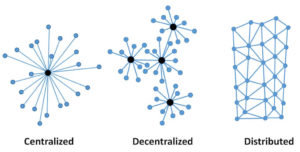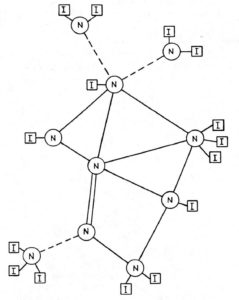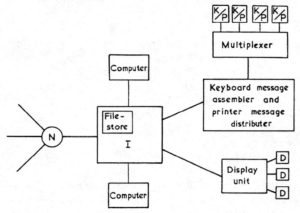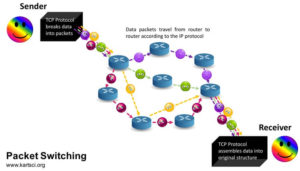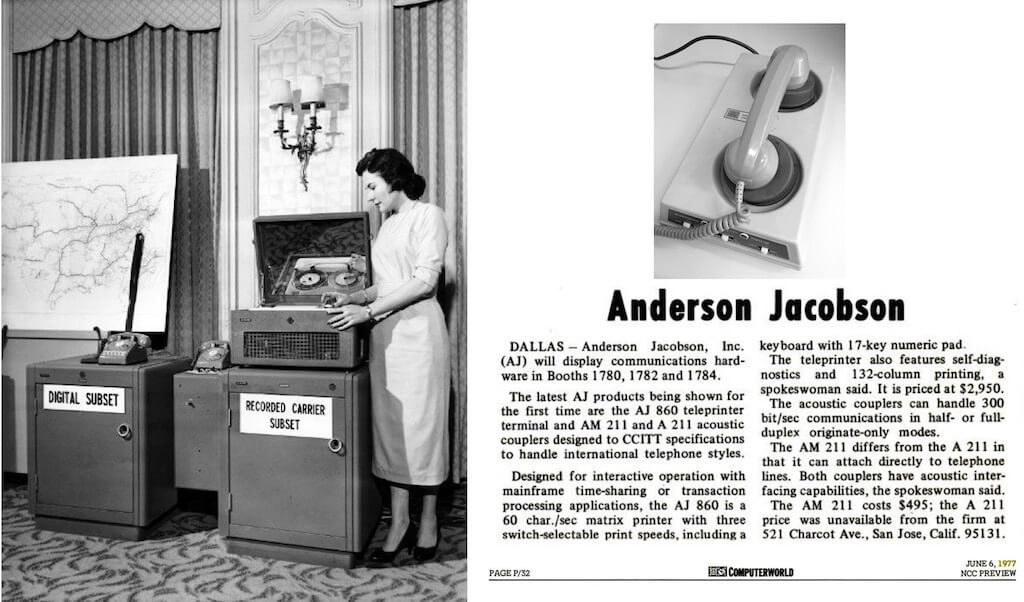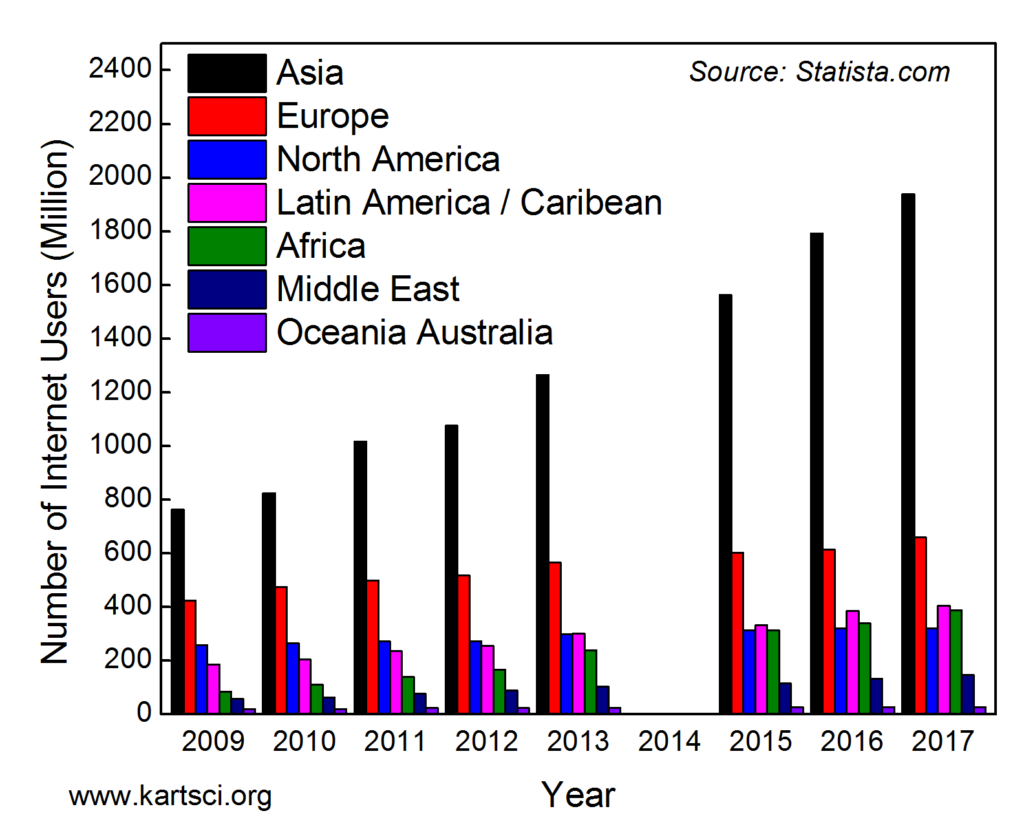The Internet and the World Wide Web.
October 2018. by Vladimir Esaulov.
The foundations of today’s global society’s computerised communications were laid in the 1960s. On this page we look at the evolution of the modern digital communication network: the Internet and its associated World Wide Web. The internet started and still functions using partly the (updated) infrastructure of the older telegraph and phone networks. Go to the From Fire and Smoke Signals to the Telegraph and Telephone and the Wireless Communications and the Radio pages for the fascinating story of long distance communications from ancient times to the appearance of the radio.
A brief historical look at earlier ideas about how information could be managed and shared, as envisaged starting from mainly the 17th century to the first post Second World War years, with references to e.g. the often cited American Vannevar Bush (1890-1974) and the unfortunately often forgotten, visionary, Belgian Paul Otlet (1868-1944) are given in an accompanying web page: Visions of hyper accessible, hyper shared information.
The appearance of computers and the necessity of sharing expensive resources for scientific needs (and also for the military) led to the studies of how to connect a user to an individual computer, how to interconnect computers and how to connect different networks of computers (which were dissimilar). There was a need for fast reliable transmission of data that did not oblige computers to queue up to transmit information. There was also concern about vulnerability of centralised or semi-centralised commmunication systems to external aggression (to which one could anyway add other types of breakdowns). The existing system was the telephone network, made for voice communication, which is different from computer communication, in which data transmission can be very fast and occur sporadically, not needing to occupy continuously a communication channel. Work on the development of this computer network was undertaken by a number of scientists in the Western world, in particular in the UK (National Physical Laboratory network), France (French network, CYCLADES) and the US (ARPANET and later NSFNET). It is appropriate to mention here the existence of an internet project in the Soviet Union.
In the mid 1950’s computers and cybernetics had become authorised in the post Stalinist Soviet Union and scientists Anatoly I. Kitov, Isaac S. Bruk, Aksel I. Berg strongly recommended the use of computers to solve problems of management and economic planning. In 1955, A.Kitov with others published the first book on cybernetics in the USSR “The Main Features of Cybernetics”. In 1958 Kitov published a paper “Electronic Computers” in which he proposed to create a network of large computing centers for solving production and planning problems. Kitov wanted to implement a Unified State Network of Computing Centers (EGSVC) (In Russian : Единaя государственная сеть вычислительных центров (ЕГСВЦ). In early ’59 Kitov’s proposals on computers were submitted to the then head of state Nikita Krustchev and met with a general approval leading to the increase in the production and wider spread dissemination of computers, but the important aspect of creating a computer network for economic management was disregarded. Later that year Kitov in his “Red Book” proposed a global computer network EGSVC for both peacetime civilian purposes and wartime national defense tasks. The proposal was not accepted and in fact led to Kitov’s exclusion from the Communist Party and dismissal. The idea did not die and was resurrected in 1964 by Victor Glushkov and others, who re-submitted a new proposal for creating an EGSVC for a global automated system for managing the country’s economy. This coincided with the end of the Khrustchev era and finally the Soviet Internet was never created.
Returning to our familiar internet: frequently people refer to the web (WWW) as the internet or vice versa. Before continuing it’s useful to clarify terms. The term Internet refers to the worldwide system of interconnected networks and computers, whereas the World Wide Web is a non proprietary decentralised hypertext document system that is available on the Internet, designed with the aim of giving users easy (free and uncensored ?) access to information.
To whom do we owe the Internet? Computer network development was based on several techniques and protocols which were developed over a number of years by the European and USA groups. We refer the reader interested in the complete history of the internet to the links at the end of this page. Besides original papers, there are in particular the books based on many interviews of the pioneer figures in this field by Haffner and Lyon(1998), Isaacson (2015) and interviews (e.g. Roberts 2008), which can help give a correct perspective about the developments in this area. Here we focus on the development of some key components of this complex system. We do not go into explanations of all the details and protocols. The interested reader can find a nice description of networks e.g. on the CCNA free study guide website.
One of the first fundamental questions one has to answer is: how should the network be constructed (its topology) and how do you go about transmitting data through it? This basic aspect was addressed in the independent works of Paul Baran in the US and Donald Watts Davies in the UK in the early 1960s (Haffner and Lyon 1998, Isaacson 2015, Campbell-Kelly 1988, Harris 2008). The way communications work today is based on the “packet switching” technique proposed by them. The second question regards internetworking i.e. how to connect together different types of networks so as to build a large network in which any pair of computers (hosts) can exchange data (packets). This means devising standard protocols which define the format and handling of packets across the network and routing them to the final destination which has a standardised address format. The word internet originated from internetwork (inter-network).
-Packet Switching and the NPL network. In 1959 in the US, Paul Baran started working at the Rand corporation on a project, whose objective was to render less vulnerable the US communications systems, that were based on short wave radios and the national AT&T telephone network. He concluded (Baran 1964, 1968, 2001) that it was necessary to switch to digital transmission and do this over a distributed network of intercommunicating nodes, where the disappearance of any node did not affect the reliability of the system. Furthermore he proposed to transmit data cut up into small “message blocks” that were independently routed through the system using available nodes and recomposed at the end. In the same years Leonard Kleinrock presented a discussion of data transmission in a network of nodes addressing queueing and delay problems in a series of reports in 1961-62 (Kleinrock 1961,1962). His work does not address message blocks (or packet switching) ideas however.
In the UK Donald W. Davies, who became superintendant of computer science at the National Physical Laboratory, was interested in remote access and sharing of computers and in data communication over the telephone network. In 1965 he independently from Baran came up with a similar idea of data communication by splitting the content into what he called “packets” transmitted over a network and assembled at the end: all this done by packet switches. His ideas were described in unpublished NPL reports in 1965-66 (now in the University of Manchester NPL archive). He proposed a UK national network based on packet switching, which was not approved and in 1966 he headed a team which produced the design for a local network to serve the needs of NPL. The team proved the feasibility of packet switching and an experimental network was created described in the 1967 “NPL Data Network” paper written with Roger Scantlebury. The system was publicly demonstrated in 1968 and the first network to use packet switching, NPL Mark I, became operational in 1969-70 period. The Mark II version operated from 1973 onwards.
-ARPANET. In 1958 the US government established the Advanced Research Projects Agency (ARPA), related to the US Defense Ministry, to develop high technology systems for the military, to some extent in response to the USSR’s launch of the first satellite – Sputnik, in 1957. In 1973 ARPA was renamed D(efense)ARPA. ARPA included an Information Processing Techniques Office whose aim was to develop systems for information processing. Its first director Joseph Licklider suggested the creation of a wide general purpose computer network for universities, business etc. In later years ARPA directors Ivan Sutherland and then Robert Taylor headed IPTO and in 1966 funding for the first network ARPANET was obtained. Lawrence Roberts was designated to build it. Roberts was inspired by the NPL system, following the 1967 presentation by R.Scantlebury in the US (Isaacson 2015), and made the crucial decision to base the network on “packet switching”. ARPANET became operational in 1969, with four nodes, each featuring an interface computer. Once operational, ARPANET was run for some time by the military. However as pointed out by Larry Roberts (see Taylor 2008) and the ARPA director Charles Herzfeld, its creation was not motivated by military considerations as it is sometimes mentioned, but in Herzfeld’s words (Wheen 2011): ARPANET “came out of our frustration that there were only a limited number of large, powerful research computers in the country and that many research investigators who should have access were geographically separated from them.” In its development ARPANET included ideas pioneered by the French Cyclade network. ARPANET expanded over the years, but in 1982 the Defense establishment split the newtork into a military part (MILNET) and a research network. At the same time a research and University oriented network: CSNET was launched by the National Science Foundation (NSF) and later became NCFNET. ARPANET was phased out. NSFNET was linked with the British and other networks to become part of today’s global Internet.
-CYCLADES and OSI. The early French network CYCLADES developed in 1972 by the Louis Pouzin and Hubert Zimmermann team, used packet switching basing everything on “datagram” delivery. It pioneered the development of end-to-end protocols with hosts being responsible for complex functions in the network: packet transmission etc. The term “datagram” was coined by Pousin and comes from data+telegram. A datagram consists of a header and a payload. The payload is the data, whereas the header contains the information sufficient for routing the data from source to destination without relying on any prior exchanges between the equipment and the network. The CYCLADES suite had four layers: Data Transmission Layer, a Transport Layer, and an Application Layer. CYCLADES influenced the development of TCP/IP and the ISO-OSI (Open Systems Interconnection) model. The idea of the ISO-OSI model was launched in 1977 in order to get industry participants to agree on common network standards. This was a seven layer model, published in 1984. It did not gain popularity and TCP/IP protocol suite is used instead of the OSI protocols.
-XEROX PARC Universal Packet(PUP) & the Ethernet. Ethernet is a network protocol developed between 1973 and 1974 with the aim of connecting numerous XEROX ALTO and other computers amongst them and to provide access to their newly made laser printer and other peripherals. Ethernet was developed by Robert Metcalfe and David Boggs and to a degree inspired by the Hawaiian ALOHA packet switching network based on wireless transmission technology that Metcalfe had studied. Ethernet stations communicate by sending data packets to other stations using 48 bit MAC addresses (media access control address), which are specific to each computer, network printer etc.. (as opposed to the IP internet addresses which are not fixed). Initially Ethernet was implemented using a shared coaxial cable to connect all computers. Use of a single cable meant that packets sent by various hosts simultaneously would “collide” and needed resending. A reduction in bandwidth occurred. A number of improvements were implemented over the years (see below). After initial deployment at PARC, from 1980, a standardised Ethernet was supported by Digital Equipment Corporation, Intel, and Xerox. The Ethernet work was supplemented by design of an internetwork protocol : PUP by Metcalfe, Bogs, John F. Shoch, Edward A. Taft (Boggs et.al. As described by them the basic function of the four layer Pup internet was the transport of datagrams, without guarantee of reliability leaving this to the hosts. PUP was used to connect the XEROX Ethernet to the ARPANET computers and some other networks and in this was a mini internet of today. Its architecture influenced the TCP protocol developed for Internet later.
–Telnet, FTP, TCP/IP. The way “packets” are transmitted over various routers is now commonly ruled by TCP/IP (Transfer Control Protocol/Internet Protocol) which was initially designed by Bob Kahn and Vint Cerf in the US in 1973, and outlined in a paper : “A Protocol for Packet Network Interconnection” (1974) and later developed with others. The Internet Protocol Suite (TCP/IP) is based on a four layer model defined in 1980 by Jon Postel. This consisted in the: Application Layer: Telnet, FTP; Transport Layer: TCP, RTP; Internet Layer: IP; Link Layer: Local Network Protocol. The TCP of the sender breaks the message into packets and the IP manages the addressing and forwarding of individual packets, which are later reassembled by the receiver TCP. The IP address associate the address to a computer name using DNS: Domain Name System introduced in 1984. The Internet currently uses two versions of the Internet Protocol (IP): Version 4 (IPv4) standardised in the 1970s and Version 6 (IPv6) which was designed in the mid 1990s. This change is related to the increase in IP address size (32 bit decimal in IPv4 and 128bit hexadecimal in IPv6). From 1983 the Internet Architecture Board (IAB) was created in the US by DARPA and oversees the development of the Internet Protocol Suite done by a number of groups.
–NIC and DNS. The Network Information Center (NIC), created in 1974, maintained and distributed a daily updated master list of host names. The NIC was based in Douglas Engelbart‘s Augmentation Research Center, at the Stanford Research Institute (now SRI International) in Menlo Park, California: one of ARPANET’s node. NIC evolved from the initial work of Elisabeth Feinler on a sort of “phone book” that connected physical locations to people on ARPANET. The DNS replaced NIC in 1985. Currently, since 1998, the responsibility for coordinating the maintenance and procedures of databases related to the Internet, in order to ensure its stable and secure operation, lies with the non-profit organisation: Internet Corporation for Assigned Names and Numbers (ICANN).
–The Spanning Tree Protocol (STP). In 1985 Radia Perlman, who worked at the Digital Equipment Corporation, invented a network protocol that builds a structure for Ethernet networks, preventing loops (i.e. two or more paths exist between end stations) and related transferring of messages to many recipients simultaneously (broadcasting).
–Modems and Routers. Data transmission in digital form goes back to the early years of the 20th century and was used in e.g. Telex transmissions. In the late 1950s AT&T developed the first commercial mass produced computer modem they called a “digital subset”, shown here, to link air defence SAGE computers around the US. It communicated at 110 bits/second. The “subset” is compared in the image with a “tiny” 1977 Anderson Jacobson acoustic coupling modem that could be used from a home computer. In 1966 the idea of an interface computer for the NPL local network using packet switching was proposed. In 1967 at ARPANET the ‘Interface Message Processors (IMP)’ were developed to manage networks by interconnected IMPs put in front of each major computer. These became today’s routers.
– Email. Simple messaging emerged in mid 1960s as a mini directory message (MIT MAILBOX, or SNDMSG). Ray Tomlison (ARPANET 1972) worked on message sending and proposed the name@host convention that is used today.
–Hypertext & WWW. In 1980, while working at the CERN (European Nuclear Physics Research Center, Geneva, Switzerland), the English computer scientist Tim Berners-Lee and the Belgian Robert Cailliau, proposed a project based on the concept of hypertext, to facilitate sharing information among researchers (Gillies and Cailliau, 2000). In 1989 Berners-Lee “married” hypertext with the Internet (TCP & the Domain Name System) and the World Wide Web document sharing became possible. The Hypertext Transfer Protocol (http) enables content transfer. Hyperlinks are embedded into hypertext documents (webpages), and include Uniform Resource Locators (URL). They are used by the Hypertext Transfer Protocol (HTTP) to locate the computer on which a webpage is stored. The term hypertext was coined by Ted Nelson in 1965 in his “Literary Machines” paper, and was referred to as “non-sequential text fragments that are linked together with hotspots called hypertext links.” Berners-Lee also wrote the first web-browser called WorldWideWeb in 1990. Note that Nelson developed his own hypertext project called Xanadu, which is still not operational although demos exist.
Visit the worlds first ever website here:
http://info.cern.ch
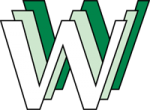
–Gopher is another Internet protocol proposed in 1991 at the University of Minnesota, that follows a client-server model, and is described as a “distributed document search and retrieval system” by its developers. Gopher was very popular initially and supported by many web browsers, but was overtaken by WWW after appearance of the NCSA MOSAIC web browser (1993) and the fact that there was an attempt to charge a fee for setting up Gopher servers.
The Internet & WWW expanded enormously (see the OPTE interconnection map above), and today provide infinite opportunities for research, education, business (including retail giants like Amazon (1994), AliBaba (1999)), person to person sales (e.g. Ebay 1995,..) and communication. A huge number of people today use social networking services like Facebook, Skype and Whatsup. Their usage and evolution timeline are given below (click to enlarge).
References.
From Cybernetics and Automated Management Systems to Digital Economics. On the occasion of the centenary of A.I. Kitov birth (2020). V.A. Kitov, P.A. Muzychkin, A.A. Nedelkin; Translation into English by A.Yu. Nitusov ; G.V. Plekhanov, Russian University of Economics. – Moscow : MAKS Press, 2020. – 120 p. ISBN 978-5-317-06480-8
P. Baran. 1964. On Distributed Communications. Memoranda RM3097, RM3103, RM3420, Rand Corporation. http://www.rand.org/about/history/baran.list.html
- P. Baran, P. 1964, On distributed communications net- works. IEEE Trans. on Communications Systems COM-12, pp. l-9.
- P.Baran. 1968. Some Changes in Information Technology Affecting Marketing in the Year 2000. Memorandum P-3717, Rand Copropration.
- P.Baran. 2002. The Beginnings of Packet Switching: Some Underlying Concepts, IEEE Communications Magazine, P42, July 2002.
- D. R. Boggs, J. F. Shoch, E. A. Taft, and R. M. Metcalfe,1980. “Pup: An Internetwork Architecture,” IEEE Transactions on Communications, Vol. Com-28, pp.612-624.
- M.Cambell-Kelly, 1988. Data Communications at the National Physical Laboratory (1965-l 975), Annals Hist Comput, 9:221-247
- Davies, D. W. 1965. Proposal for the Development of a National Communication Service for On-Line Processing, unpublished memorandum, December 15. National Archive for the History of Computing: National Physical Laboratory Collection.
- Davies, D. W. 1966. Proposal for a Digital Communication Network, unpublished memorandum, June. 1966
- Davies, D. W. 1966. A Computer Network for NPL, unpublished memorandum, July 28. 1966
- Davies, D. W. 1968. Communication networks to serve rapidresponse computers. Proc. IFIP ‘68, pp. 650- 658. 1968
- Davies, D. W. 1968. The principles of a data communication network for computers and remote peripherals. Proc. IFIP ‘68, pp. 709-715, 1968
- Davies,D.W. 1969. Proposal for an Experimental Low Speed Data Communication Network, unpublished memorandum, July 15. 1969
- Davies, D. 2001. ‘An Historical Study of the Beginnings of Packet Switching.’ The Computer Journal. 44(3): 152-162, 2001
- J.Gillies and R.Cailliau, 2000, How the Web Was Born. Oxford University Press. p. 197. ISBN 9780192862075
- K.Haffner and M.Lyon, 1998. Where Wizards Stay Up Late: The Origins Of The Internet, Simon & Schuster, ISBN-9780684832678.
- Harris Trevor, 2008. Who is the Father of the Internet? The case for Donald Watts Davies. in 6th International Conference on Media to be held in Athens, Greece on May 19-22, 2008. Published in “Variety in Mass Communication Research”, Edited by Yorgo Pasadeos, 2009
https://www.academia.edu/378261/Who_is_the_Father_of_the_Internet_The_Case_for_Donald_Davies - W. Isaacson, 2015, The Innovators: How a Group of Hackers, Geniuses, and Geeks Created the Digital Revolution, Simon & Schuster, New York, 2015, ISBN:9 781476708706
- L.Kleinrock,1961, “Information Flow in Large Communication Nets,” Ph.D. Thesis Proposal, Massachusetts Institute of Technology, May 1961. https://www.lk.cs.ucla.edu/bibliography-public_reports.html
- L. Kleinrock, 1961, “Information Flow in Large Communication Nets,” RLE Quarterly Progress Report, Massachusetts Institute of Technology, July 1961.https://www.lk.cs.ucla.edu/bibliography-public_reports.html
- L.Kleinrock, 1962, “Information Flow in Large Communication Nets,” RLE Quarterly Progress Report, Massachusetts Institute of Technology, April 1962. https://www.lk.cs.ucla.edu/bibliography-public_reports.html
- L. Kleinrock,(1964). Communication nets, stochastic message flow and delay. New York: McGraw-Hill
- R.Metcalfe and D. Boggs. 1976. “Ethernet: Distributed Packet Switching for Local Computer Networks“, July 1976
- R.Taylor in the – Oral History of Robert (Bob) W. Taylor , 2008, Computer History Museum Archive:
- A.Wheen, Dot-Dash to Dot.Com: How Modern Telecommunications Evolved from the Telegraph to the Internet. Springer-Verlag New York, 2011. ISBN: 978-1-4419-6759-6. DOI: 10.1007/978-1-4419-6760-2
Links
- Ian Peter’s website is an excellent resource on Internet history. http://www.nethistory.info
- http://www.internet-guide.co.uk/NSFNET.html
- https://www.internetsociety.org/internet/history-internet/brief-history-internet/
http://www.historyofcomputercommunications.info

